Exploring the Google Sheets AI Formula: Your Quick Guide to Smarter Spreadsheets
Daily tasks in Google Sheets often involve more than just numbers. You may need to generate text for campaigns, summarize long customer reviews, categorize information from surveys, or quickly perform sentiment analysis on social media comments. These common, time-consuming tasks often slow down your workflow.
Fortunately, your spreadsheet is getting smarter. The new Google Sheets AI formula is an innovative addition. It’s built to automate your most demanding text tasks, significantly increasing productivity and refining your data analysis.
Dive into this guide to unlock the full potential of the AI function in Google Sheets and revolutionize how you work with data.
Meet the AI function in Google Sheets
So, what exactly is this AI function in Google Sheets? And how is it different from the familiar Google Sheets formulas you’ve been using for years?
The AI function in Google Sheets is a new capability that leverages artificial intelligence to understand and generate natural language. Unlike traditional Google Sheets formulas, which perform calculations or manipulate data based on strict rules (such as SUM() or VLOOKUP()), the AI formula uses large language models (LLMs) to process text prompts and deliver intelligent responses.
With this AI function in Google Sheets, you can:
- Generate text: Create marketing copy, product descriptions, or email drafts.
- Summarize information: Extract key takeaways from long text blocks.
- Categorize information: Automatically tag and organize data.
- Analyze sentiment: Determine the emotional tone of a text.
Is the AI function and Gemini the same?
You might also be wondering: What’s the difference between this AI function and the Gemini panel you might see in Google Workspace?
The Gemini panel is a broader conversational AI tool. It helps you with various tasks across Google Workspace apps, including Docs, Gmail, and Sheets. The AI function in Google Sheets, however, is a specific formula generator. You type it directly into a cell. This enables targeted, AI-powered text manipulation directly within your datasets.
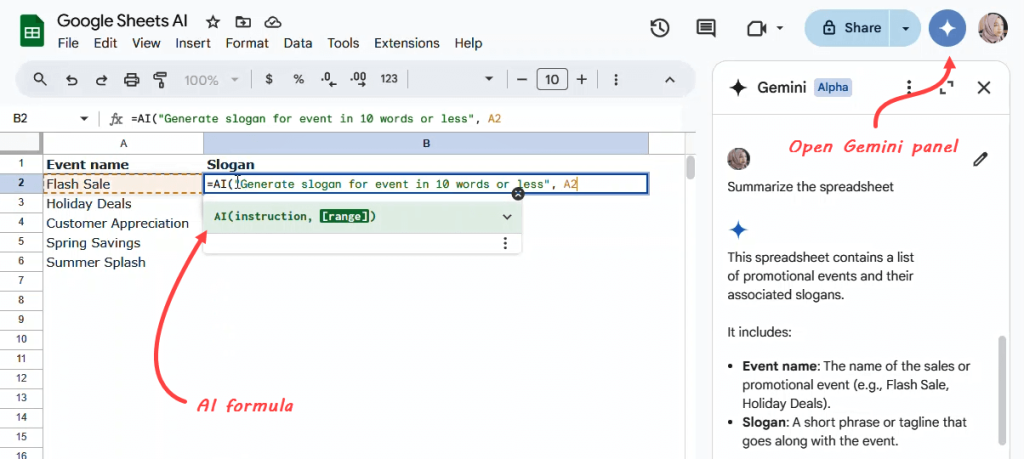
This exciting new capability is part of Gemini for Google Workspace. If you can’t find these AI features, your administrator may need to enable Alpha features for your organization. It’s also available to users in Google Workspace Labs.
How to speak AI in Sheets: The basics
Interacting with the AI model in Sheets is straightforward. Think of it like giving instructions to a highly intelligent assistant. You type what you want in plain English.
We’ll guide you through the syntax, provide examples, and demonstrate how to use it.
Syntax
The basic structure of the AI formula:
=AI("prompt", [optional_cell_reference])
The AI function has two arguments:
prompt: This is the mandatory first argument. It’s a text string enclosed in double quotation marks, where you write clear and specific instructions for the AI model.[optional_cell_reference]: This parameter is optional. If included, it typically refers to a single cell (likeA2), a range of cells (likeB1:B10), or a literal value that the AI function should use as additional context for its response.
Basic examples
Examples with one argument: These examples don’t require external data from a cell; the AI generates content or provides insights based solely on your instructions.
=AI("Generate three compelling headlines for a blog post about email marketing tips.")=AI("Give me a brief overview of current trends in social media advertising.")
=AI("What are the main categories of buyer intent in e-commerce?")=AI("What is the general sentiment around using AI in creative marketing?")
Examples with two arguments: These examples demonstrate how the AI function can be more dynamic by interacting with your existing data in Google Sheets.
=AI("Write an Instagram caption promoting the product for women.", A2), whereA2contains a product name, for example, “Fruity Bar Multigrain Snack”.=AI("Analyze sentiment for this review and tag them as Positive, Negative, or Neutral.", D2), whereD2contains a short online product review such as “Great tool for small businesses!”.=AI("Extract the key themes from these customer survey responses:", B10:B12), whereB10:B12contains open-ended customer survey responses.=AI("Write a one sentence summary of the features, focusing on AI and automation.", C5:F6), whereC5:F6contains your product features.
How to use the AI formula in a sheet
Here’s a quick step-by-step tutorial on how to use the AI function in your spreadsheet:
- Open a spreadsheet from Google Sheets. You can use an existing one or start fresh.
- In a cell, enter an AI function. Begin with an equals sign followed by your AI formula.
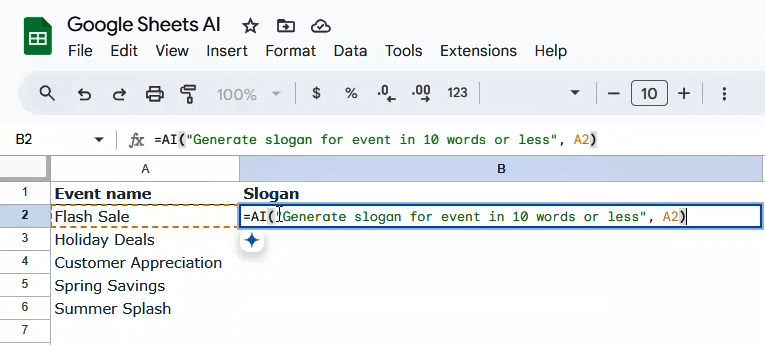
- Select the cell or cells with an AI function. You can apply this to a single cell or drag the fill handle to apply it to multiple cells at once.

- Click Generate and insert. This button usually appears near the cell or in the context menu after you’ve entered an AI formula.
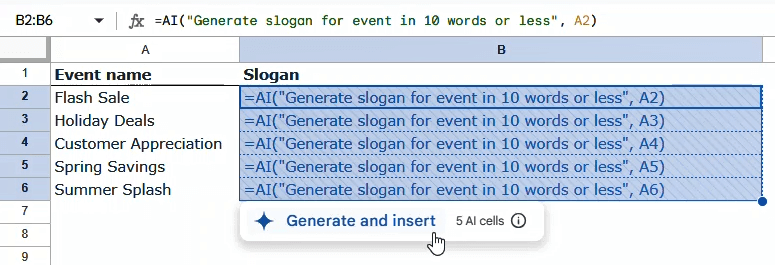
- Optional: To refresh the output, click Refresh and insert.

That’s it! The AI function will then process your request and populate the cell(s) with the generated content.
Note: When you click “Generate and insert” or “Refresh and insert,” the content gets added to your sheet. It’ll show up as an edit by you in the version history.

What you can do with the Google Sheets AI formula
The Google Sheets AI formula can transform how you handle text-based tasks directly within your spreadsheets.
Imagine you run a small business selling flowers online. You’re juggling multiple ad platforms, gathering customer surveys, sending marketing emails, and so on. You constantly pull data into Google Sheets for a central repository and analysis. The AI formula in Google Sheets can revolutionize how you manage your workflow.
Let’s explore some of the most impactful ways you can integrate this formula into your daily workflow.
Generate text
The AI function in Google Sheets excels at creating new content. You give it a prompt in plain language, and it generates text based on your instructions. This is incredibly useful for speeding up content creation in marketing.
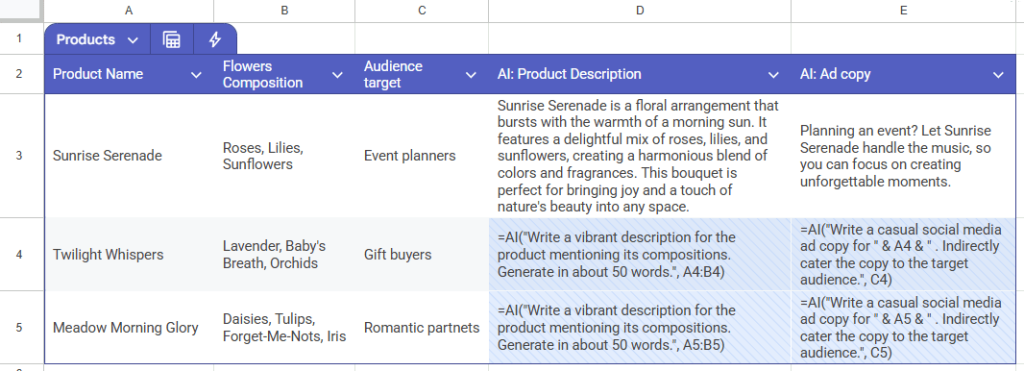
Examples
- Product descriptions:
=AI("Write a vibrant description for the product mentioning its compositions. Generate in about 50 words.", A3:B3), whereA3contains “Sunrise Serenade” andB3contains “Roses, Lilies, Sunflowers.” - Ad copy generation:
=AI("Write a casual social media ad copy for " & A3 & ". Indirectly cater the copy to the target audience.", C3) - Social media post:
=AI("Create an Instagram post for the new product. Use 2 emojis and three hashtags.", A3) - Email subject lines:
=AI("Suggest 3 enticing email subject lines for a flash sale on the product.", C3) - Email response:
=AI("Write a personalized email reply to the sender based on their inquiry without repeating the email subject.", A3:C3), whereA3contains the sender’s name,B3provides the email subject, andC3includes the full details of the sender’s message.
Limitation
While the AI model is powerful, the accuracy of generated content can vary. It may occasionally produce text that sounds generic, is factually incorrect, or doesn’t perfectly match your brand’s specific tone.
Always review and edit the output to ensure it aligns with your brand voice and factual requirements. Think of the formula generator as a creative assistant, not a final decision-maker.
Summarize information
Drowning in long reports, extensive customer feedback, or detailed project notes? The AI function can quickly extract key takeaways, turning large blocks of text into digestible summaries. This is incredibly useful for quick data analysis.
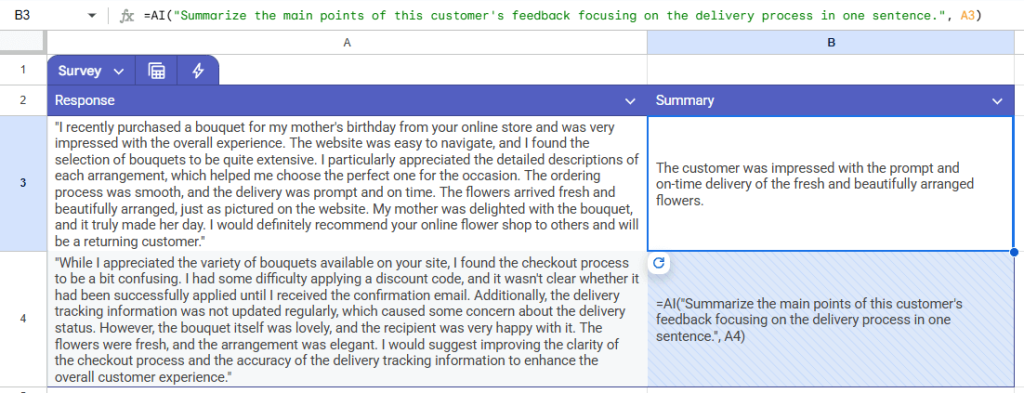
Examples
- Summarizing customer survey responses:
=AI("Summarize the main points of this customer's feedback focusing on the delivery process in one sentence.", A3)
- Call summaries:
=AI("Provide a summary of the conversation with potential customer in bullets.", C3) - Product roadmap overviews:
=AI("Summarize the next three key milestones from this product roadmap description.", E3) - Competitor analysis snapshots:
=AI("Extract the main competitive advantages mentioned in this competitor analysis text.", J2)
Limitation
AI summaries may occasionally overlook subtle nuances or specific details crucial for in-depth analysis. For critical decisions, always refer to the original, full text. The AI model provides a quick overview, not a replacement for a thorough review.
Categorize information
Organizing unstructured text data, like diverse customer inquiries or product reviews, can be tedious. The AI function in Google Sheets can automatically tag and sort your data, making data organization much more efficient and supporting better data analysis.
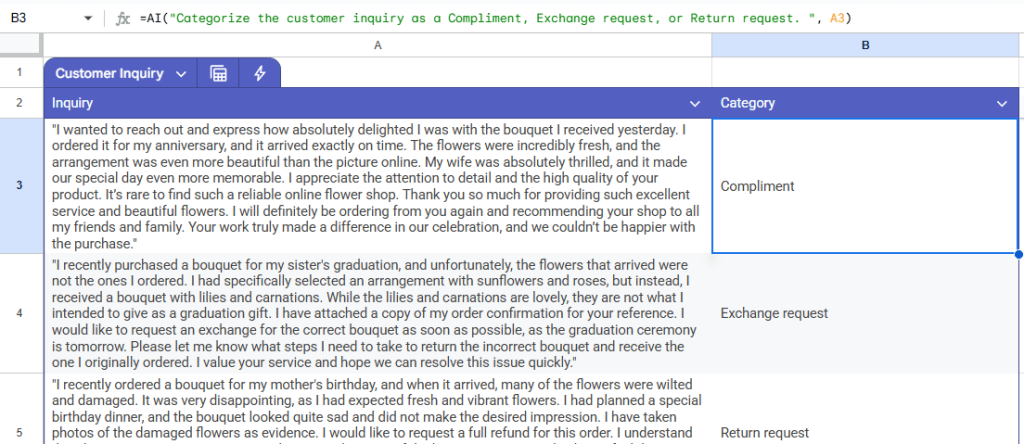
Examples
- Categorize customer inquiry:
=AI("Categorize the customer inquiry as a Compliment, Exchange request, or Return request. ", A3) - Group content ideas:
=AI("Assign a primary marketing blog topic to this idea: 'SEO', 'Email Marketing', 'Social Media', 'Content Creation', 'E-commerce Tips'.", A3), whereA3contains the description of the blog idea. - Tag return reasons:
=AI("Categorize the reason for this e-commerce return: 'Damaged', 'Wrong Item', 'Customer Changed Mind', 'Too Late'.", C3)
Limitation
The accuracy of categorization depends heavily on the clarity and distinctness of your defined categories. If categories overlap or the input text is ambiguous, the AI model might struggle to make a precise judgment.
Always provide clear, mutually exclusive categories when prompting. You may also encounter instances where the AI function misinterprets context, necessitating human oversight to correct.
Sentiment analysis
The AI function can help you determine the emotional tone of text data, making sentiment analysis accessible directly in your spreadsheet. This is incredibly useful for understanding how your customers feel about your brand, products, or campaigns.

Examples
- Customer feedback sentiment:
=AI("Assess the sentiment of this customer feedback. Respond with 'Positive', 'Negative', or 'Neutral'.", A3) - Competitor mentions analysis:
=AI("Identify the sentiment expressed in this online comment about our competitor's flower quality. Is it Positive, Negative, or Neutral?", A3)
Limitation
Sentiment analysis can be challenging for AI models due to the complexities of human language, including sarcasm, humor, and cultural nuances. A comment like “Oh, wow, the delivery of dead flowers was just spectacular!” would be difficult for an AI to accurately process as Negative. For critical interpretations, human judgment remains essential.
Can the AI function work with numeric values?
You’ve seen how the Google Sheets AI formula can completely change how you handle text-based tasks.
But numbers? That’s a whole other story.
For many businesses, numbers drive decisions. From sales figures to ad spend to customer acquisition costs, understanding your metrics is critical. However, the AI in Google Sheets is primarily focused on text. It won’t pinpoint why revenue dropped last month or identify patterns in your ad performance. If you need insights into your metrics, use Coupler.io. It’s a reporting automation platform that enables you to collect data from over 70 business applications and transform it into insightful reports. You can load these reports to:
- Spreadsheets (Google Sheets, Excel), for example, connect API to Google Sheets.
- BI tools (Looker Studio, Power BI)
- Data warehouses (BigQuery, PostgreSQL, Redshift)
Beyond just pulling data, Coupler.io also lets you clean and transform your raw datasets to make them analysis-ready. This includes options to hide unnecessary columns, edit column names and types, filter data, and even add custom columns using simple formulas. Check out what it looks like in this interactive form.
Additionally, Coupler.io provides pre-designed dashboards and templates to deliver instant insights into your business data. And this is where AI power is covered.
Coupler.io AI Insights for deeper analysis
While Google Sheets’ built-in AI formulas excel at handling text within cells, Coupler.io’s “AI Insights” feature takes a step further, providing broader, strategic analysis of your quantitative data.
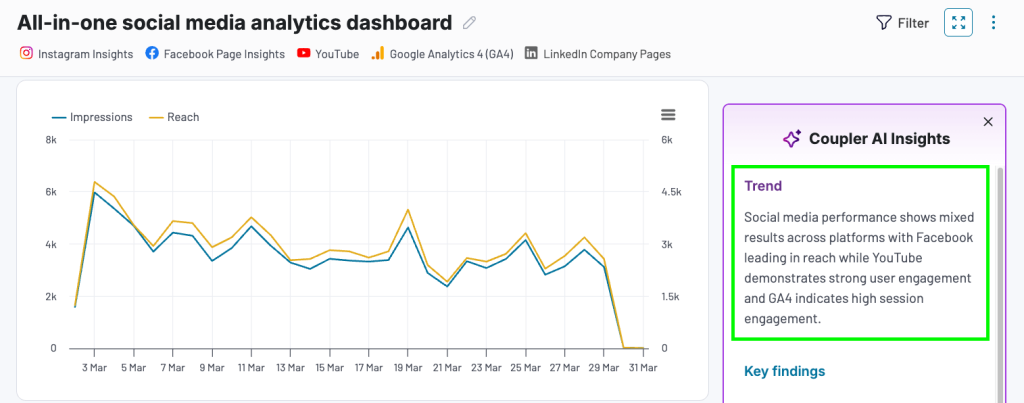
Coupler.io’s AI Insights is powered by the latest version of Claude (similar to the AI models behind Gemini AI and other ChatGPT-like capabilities). This feature is built into Coupler.io dashboards for marketing, finance, sales, and more.
Note: AI insights is only available for Coupler.io dashboards, not templates for external BI tools.
It automatically interprets all the datasets on your entire dashboard, providing summaries of key trends and actionable recommendations.
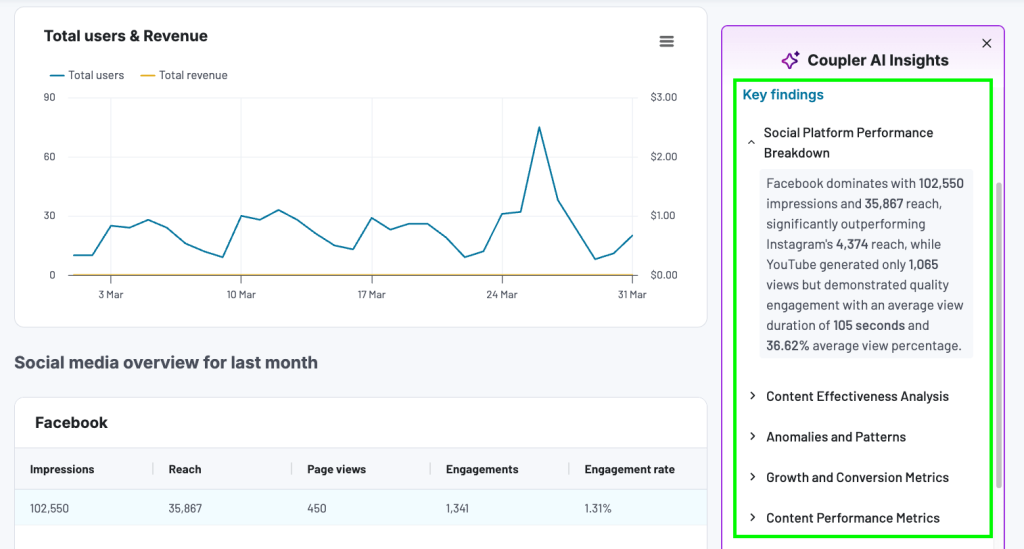
It doesn’t just process text; the AI assistant analyzes the complex relationships and numbers across your combined datasets. This helps you identify overarching trends, hidden anomalies, and strategic opportunities within your marketing performance. It then presents them as actionable intelligence. For instance, it can alert you if your average customer acquisition cost suddenly spikes, and then suggest potential reasons or solutions based on your connected data.
By combining Coupler.io’s robust automation for data collection and transformation with its intelligent “AI Insights” feature, you can move beyond just manual data analysis in Google Sheets. This allows you to gain a deeper, more actionable understanding of your business performance.
As a result, you’ll spend less time searching for answers and more time making wise, informed decisions.
Ready to see how AI can transform your data analysis and workflow? Start your 7-day free trial of Coupler.io today and experience the power of AI Insights for your own dashboards!
Beyond the basics: Combination of AI function with other Google Sheets formulas and features
The AI function in Google Sheets becomes more powerful when combined with standard formulas and features. You can create complex prompts and use the AI output to automate tasks. This makes your spreadsheet more intelligent and helps you manage workflows more effectively.
Building more dynamic prompts with concatenation
Often, your AI formula prompt needs to pull information from multiple, separate cells to create a complete and dynamic request. You can easily construct this full prompt string before passing it as the first argument of the AI function. How? By using the ampersand (&) operator for concatenation. This is a common and flexible way to join text strings in Google Sheets.
Let’s say you own an online shop. You have a spreadsheet with details about new leads. Column A has their names, and Column C lists what they’re interested in. You want to create quick, personalized emails for each lead.
Here’s a simple formula you can use in a cell (like D2) to generate an email draft:
=AI("Write a short introductory email to a new lead named " & A2 & " mentioning their interest in " & C2 & ". Keep it friendly and concise.")
This formula pulls the name from A2 and their specific interest from C2 to create a unique email for every lead.

With this method, the AI formula can create personalized content for each row, even if your data isn’t in a continuous range of cells.
Using the AI output
Once you have your AI-generated results, what’s the next step? From actionable insights to full automation, there are numerous ways to leverage the data.
Managing workflow
If you manage customer feedback, the AI function can help prioritize follow-ups. For example, you might keep customer reviews in Column C and run sentiment analysis with AI in Column D.
You can flag negative reviews for immediate attention. For example, you could use this formula in Column E:
=IF(D2="Negative", "Urgent follow-up needed", "No action needed")
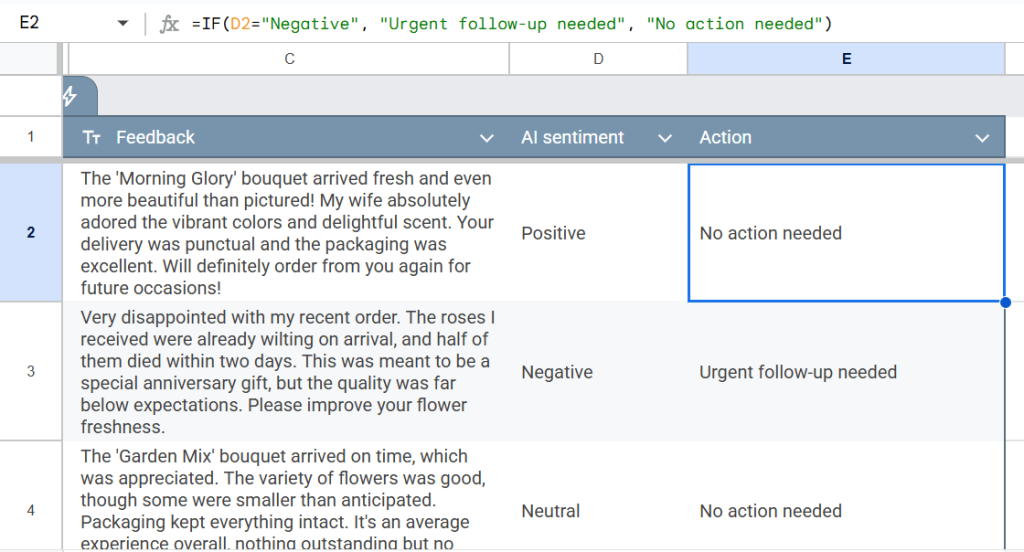
This approach streamlines decision-making. Here’s what else you can do with AI outputs:
- Use sentiment analysis on customer feedback to generate email responses.
- Tag and categorize support tickets so they are routed to the correct team.
- Spot trends in survey comments or ratings for deeper insights.
Automation
Automation takes things up a level. For example, you can automate sending emails right from Google Sheets. This is possible with Google Apps Script or third-party tools like Zapier.
If you’re comfortable with a bit of coding, you could write a script that automatically reads the email drafts generated by your AI formulas. Here’s the idea:
- Use the AI formula to generate emails (e.g., in Column D).
- Write an App Script to send emails. The script grabs data from your sheet, like email addresses and AI-generated drafts.
- Set up a trigger to schedule the script. For example, have it run every morning to send emails automatically.
It’s exciting that you can transform your Google Sheets into an AI-powered email marketing system. With this setup, you can save time and reduce manual work. You don’t need to write or send emails one at a time. Plus, everything stays organized in your sheet, from draft emails to sent statuses.
Key takeaway
By combining the AI formula with features like concatenation, conditional logic, and automation tools, you can manage workflows, save time, and boost productivity. Explore these possibilities, and you’ll discover just how powerful your spreadsheets can become.
AI-powered tools like Google Sheets AI can transform your workflow, but they’re not without their boundaries. It’s important to understand their limits and use them responsibly.
Here’s what you need to know.
Technical limitations

Here are some technical aspects to be aware of when using the AI formula:
- Responses are limited to text. The AI function is designed to generate or analyze text. It won’t directly create charts, format your spreadsheet, or perform complex mathematical calculations that aren’t text-based.
- Limited data access. The AI function doesn’t have access to your entire spreadsheet, other sheets in your Google Workspace, or other files in your Google Drive. It can only process the data you explicitly provide to it within the formula. To provide the AI model with the most context, always add relevant data to your current spreadsheet and use the optional input argument, such as referencing a cell or range, as we’ve demonstrated.
- No Undo/Redo for AI outputs. Unlike standard edits, you can’t simply click “Undo” or “Redo” to revert the AI-generated content. If you want to change the output, you’ll need to manually re-run the function or regenerate the output.
- You can’t create a custom function with the same name “AI”. If you try, your custom function will be remapped to the built-in Sheets AI function, causing conflicts.
- Embedded AI functions are not supported. This is a crucial point. You cannot directly nest the AI function within other Google Sheets formulas like
IForVLOOKUPas a direct argument.
- Example: A formula like
=IF(AI("Analyze sentiment", A2)="Negative", "Urgent follow-up.", "No action needed.")will not work as theAIfunction is not supported as a direct nested argument. - Solution: If you need to make decisions based on AI-generated output, you’ll need to generate the
AIresult in one cell (e.g., inB2), and then reference that result in a separate formula (e.g.,=IF(B2="Negative", "Urgent follow-up.", "No action needed.")).
- “AI function not available”: If you see this message, it could mean a few things:
- You’re not a participant in the Google Workspace Labs or Alpha program where this feature is available.
- You don’t have access to the AI function because of your Admin settings.
- Your language setting in Google Sheets might not be set to English.
- Generation limits: The AI function has both short-term and long-term generation limits. If you reach a long-term limit, you might temporarily be unable to click “Generate.” In this case, you can usually wait for 24 hours and then try again.
- Batch generation limits: While you can select multiple cells with AI functions to generate outputs, only the first 200 selected cells will be processed in one batch. For larger sets, you’ll need to wait for the first batch to complete, then select more cells to continue generation.
Accuracy limitations
Even the most advanced AI model isn’t perfect.
Your Google Sheets AI formula might misinterpret data or give incomplete results if the input is unclear.
To improve accuracy, you can:
- Provide clear and specific instructions to guide the AI.
- Always review AI outputs for errors or misinterpretations.
- Clean and organize your data before using the formula. Messy or poorly structured data often results in incorrect outputs.
Ethical and responsible use
Using the AI formula in Google Sheets responsibly is just as important as knowing its strengths. As you integrate AI features into your workflow, consider these key tips for responsible use:
- Data privacy: Be extremely cautious with sensitive personal or customer data. Avoid prompting the AI with confidential information unless you’re confident in your data policies and the tool’s privacy safeguards.
- Transparency: If AI plays a significant role in generating content or making decisions that impact your customers, consider being transparent about its use. For example, if an email draft was AI-powered, you might subtly mention it was “Powered by AI.”
- Accountability: Remain responsible for any decisions made or content published use AI-generated outputs.
By staying mindful of these points, you can fully harness the power of AI while keeping your work ethical and secure.




